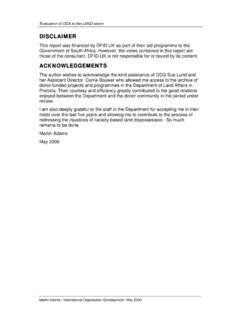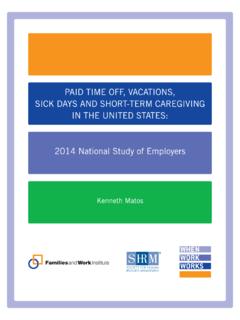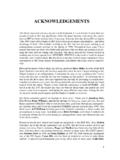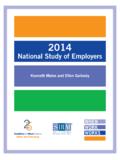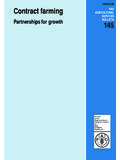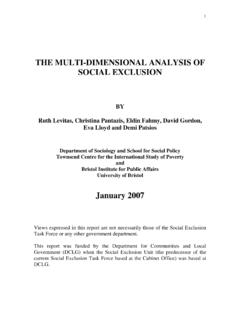Transcription of Creating a self-improving school system V2 FINAL
1 Creating a self - improving school system David H Hargreaves, July 2010 Inspiring leaders to improve children s lives Resource Schools and academies The crisis of the world is, above all, an institutional crisis demanding institutional innovation (Peter Drucker) The future is already here: it is just not distributed very well (William Gibson) Contents Executive summary 3 Introduction 4 Family virtues 6 The local solutions approach 9 Co-construction in family clusters 10 Expanding system leadership 11 Beyond the self -managing school 12 Conditions of a sustainable self - improving system 13 Towards a mature self - improving system 20
2 Conclusion 23 Acknowledgements 24 References 25 3 Executive summary In an era of diminishing centralisation, accelerating the rate and depth of school improvement and reducing the number of underperforming schools requires a new vision. Since the birth of school improvement in the 1980s, the quality of school leadership has increased sharply and most schools have gained experience of working in partnerships and networks of many kinds. Increased decentralisation offers an opportunity for the school system to build on these and become self - improving .
3 There are four building blocks of a self - improving system : clusters of schools (the structure); the local solutions approach and co-construction (the two cultural elements); and system leaders (the key people). These are already partially in place but need to be strengthened so that schools collaborate in more effective forms of professional development and school improvement. This thinkpiece explores the conditions necessary to achieve a sustainable, self - improving school system , with a particular focus on the development of school clusters and the associated provision of cluster leaders. A sketch of how such a system might evolve over the next five years is offered.
4 4 Introduction On 18 October 1976, the UK s Labour prime minister James Callaghan gave a speech in Ruskin College, Oxford that started what became known as the Great Education Debate. At this time it was very unusual for a prime minister to discuss education policy in public. In his near-apologetic approach to the subject, Callaghan argued that education was now too important to be left almost entirely to the teaching profession and that many voices, including that of a prime minister, needed to be heard on the purposes of schooling and educational standards. More was being demanded from schools, and core issues, such as the desirability of a national curriculum and a stronger inspectorate, should be addressed.
5 Up to this point, England had a highly decentralised education system . The Ruskin speech marked the beginning of a new phase, which eventually led, under the Conservatives, to the 1988 Education Reform Act that introduced a national curriculum and a new assessment system . This was an unprecedented degree of centralisation but it was matched by a degree of decentralisation that delegated new financial powers to schools, and to their headteachers, the spirit of which was neatly captured in Caldwell and Spinks s The self -managing school , also published in 1988. Significantly, this second half of the 1980s gave birth to the school improvement movement, which was driven both centrally by a more hands-on education department and some local education authorities as well as by more enterprising headteachers.
6 Successive governments, both Conservative and Labour, have for over 20 years pursued this combination uneasy to some of centralisation in some respects and decentralisation in others. The constant challenge has been to minimise variation, not just within and between schools but also between local authorities, which has led central government to take ever greater powers of intervention, backed by national field forces and strategies. school improvement has thus come to be defined in terms of the processes of intervention in schools that are deemed, by whatever measure, to be underperforming. Much has been achieved, yet it has to be conceded that not all schools have improved substantially or even sufficiently over this last quarter century.
7 Should we persist with these same strategies for school improvement or is it time for a new vision? Two important changes have occurred that suggest the need for a new direction. First, the calibre of school leadership has improved, in many places to a dramatic degree, reflecting the National College s central task of ensuring the provision of leaders with relevant capabilities. Schools are more accustomed to managing their own financial affairs and many have developed sophisticated continuing professional development (CPD) for their staff. Second, virtually every school has experience of partnership with other schools, and the education service is now more networked.
8 school leaders are more aware of schools as a system , and the coalition government s plans are evidently intended to change the shape of this system . A new balance is being struck between centralisation and decentralisation, with a clear reduction in centralised action, at both national and local levels, and a matching increase in the powers and responsibilities of schools. In this thinkpiece, I argue that increased decentralisation provides an opportunity for a new vision of school improvement that capitalises on the gains made in school leadership and in partnerships between schools. It would usher in a new era in which the school system becomes the major agent of its own improvement and does so at a rate and to a depth that has hitherto been no more than an aspiration.
9 It is essential that such a change would enhance parental confidence in the quality of schools and the effectiveness of teachers, on both of which better educational outcomes depend. This short thinkpiece suggests what could be done to realise such a vision. It is not a detailed policy prescription, but a sketch of the main lines of action that would need to be taken. school improvement depends on improved leadership, but the necessary scale, speed and sustainability of leadership development cannot be achieved by centralised action alone. In the College s innovative local solutions approach to the shortage of headteachers, succession planning takes place across networks of schools (in the local authority or the diocese) in ways that are responsive to local circumstances.
10 5 A similar approach is being adopted elsewhere by the College to increase the provision of middle leaders through local clusters of schools as well as in City Challenge. In this sense, the College is acknowledging changes in the system and then developing them further in the interests of better leadership provision. Scaling up such local solutions necessarily entails new ways of deploying the headteachers of successful schools, who accept responsibilities beyond the boundaries of their own schools and are prepared to help other schools. The College s action with such headteachers in the form of national leaders of education (NLEs) and local leaders of education (LLEs) runs parallel with the emergence of larger groups of schools in forms such as federations and chains (Hill, 2010), in addition to clusters of schools serving a wide variety of functions, all of which is altering the shape of the school system .











